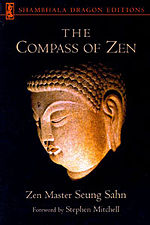- The Compass of Zen
-
The Compass of Zen 
The Compass of Zen first edition cover.Author(s) Seung Sahn
Hyon GakCountry United States of America Language English Genre(s) Zen Buddhism Publisher Shambhala Publications: Distributed in the United States and Canada by Random House Publication date 1997 Media type Print (Paperback) Pages 394 ISBN 1-57062-329-5 OCLC Number 36755855 Dewey Decimal 294.3/927 21 LC Classification BQ9266 .S47 1997 The Compass of Zen is a book of teachings by the late Seung Sahn Soen Sa Nim, a compilation of talks given by him since 1977 that were then edited by his student Hyon Gak (Paul Muenzen). Designed to offer readers an introduction to the teachings of the Mahayana, Hinayana and Zen traditions, an earlier—and more crude—version of the current text had first been drafted by Seung Sahn Soen Sa Nim in the early 1970s. Until it was first published by Shambhala Publications in 1997, much of the material was already being used in the Kwan Um School of Zen curriculum. Rather than pretending to be a work of academia, The Compass of Zen was presented in everyday language for its readership. In addition to coverage of the aforementioned topics, the book also contains Seung Sahn Soen Sa Nim's "The Ten Gates", a glossary of terms, and his lineage chart. "The Ten Gates" is his own kong-an curriculum for students in his Kwan Um lineage, each one being followed by commentary by him in the text. Today there are Twelve Gates.[1]
Most people think of Zen as being simple, direct, and unattached. Although Zen teachings can be easily forgotton and overlooked, the people who study them turn into people who possess a fundamental insight into life, and are not fooled by appearances or ideas. The fact is that almost everything about Zen's presentation, practice, and rituals is aimed at producing people who give up their good sense with the promise of a greater gain in the future. The practice gives people something to look forward to and something to aim for. As some can find life to be meaningless with no direction, Zen followers see the light in all situations. Zen teachings do not provide answers to life, and most people get that extremely confused. It simply gives people an insight to looking at things in a new way.Contents
Zen Following Other Religions
The idea that Taoism and Chan (Zen) were cross-fertilized is a typical modern misunderstanding, and one that is usually perpetuated by scholars (and usually Western ones) — not Chan masters. Taoism and Chan have separate histories. In the development of Chan in China, none of the six patriarchs had any influence from Taoism. Bodhidharma (Da Mo), Hui Ke, and Seng Can all taught at Shaolin. Dao Xing, Hong Ren, and Hui Neng taught at only the Buddhist temples called Baolin and Dongshan.
You can mainly see differences of the priests of Taoism and Zen: Zen monks shave their head, are vegetarian, avoid wine and intoxication, value the Heart Sutra, and practice celibacy; Taoist priests generally have a full head of hair, drink wine, value the Dao De Jing, and are permitted to have wives.
You can also look at their meditation techiniques. In Zen, practitioners keep their mind on the void. In Taoism, visualization is used extensively in meditation. From a Zen perspective, these visualizations are considered a “deviation” because they cause thoughts to arise, which conflict sharply with Zen teachings (but not with Taoist teachings).
The most important thing is to find out what is the most important thing. -Shunryu Suzuki
The Three Vehicles of Zen and Buddhism
In order to clarify the variations between the many different traditions/schools of Zen Buddhism, the schools are often divided into the three "Yanas", meaning 'Vehicles' or 'Paths'. These three are; the Theravada, Mahayana and Vajrayana.
First is the Hinayana or Theravada. Hinayana literally translates to the "lesser Vehicle". The teachings on the Four Noble Truths and meditation form the basis of this practice. The Hinayana vehicle represents the class of practitioners who seek enlightenment for themselves. All traditions accept the Hinayana teachings as being authentic (and they are generally considered to be the earliest).
Next is the Mahayana, or "greater Vehicle". It emphasizes universal compassion and the selfless ideal.
Finally, there is the Vajrayana. This literally translates to "Diamond Vehicle". This vehicle is very much like Mahayana, however instead of taking an emotional approach, it takes a spiritual approach. It harnesses psycho-physical energy as a means of developing profoundly powerful states of concentration and awareness.
Hell is not punishment, it's training. -Shunryu Suzuki
See also
- Taoism
- Origins of the Tao
- Buddhism in the United States
- Kwan Um School of Zen
- Timeline of Zen Buddhism in the United States
Notes
- ^ Compass of Zen, Preface
References
- Seung Sahn; Hyon Gak (editor); Stephen Mitchell (foreword) (1997). The Compass of Zen. Shambhala Publications. ISBN 1570623295.
- "Hyon Gak". Shambhala Publications. http://www.shambhala.com/html/catalog/items/author/869.cfm. Retrieved 2008-01-21.
- Woodhouse, Mark; Elmira Coll (1997-11-01). "Book reviews: Arts & humanities". Library Journal 122 (18): p. 81. ISSN 0363-0277.
- http://www.a1-optimization.com/articles/Article/Zen-meditation--Techniques-to-Learn/81208
- http://www.universitip.com/term-papers/Basic-Philosophical-Differences-between-Zen-Buddhism-and-Taoism--202250084.html
- http://www.amazon.com/Three-Pillars-Zen-Teaching-Enlightenment/dp/0385260938
- http://about.pricegrabber.com/search_getprod.php/masterid=/isbn=9780807012017/search=9780807012017/st=query&mode=about_buddhism
- http://www.ebudhaindia.com/india/three_vehicles.htm
- Aitken, Robert/ Taking the Path of Zen. 1982. 149 pp. North Point Press. San Francisco, California. ISBN 0-86547-080-4.
- Herrigel, Eugen/ The Method of Zen. 1976102 pp. Routledge & Kegan Paul. London. ISBN 0-7100-8330-0.
Buddhism Categories:- Zen stubs
- Kwan Um School of Zen
- Zen studies books
- Zen texts
Wikimedia Foundation. 2010.
